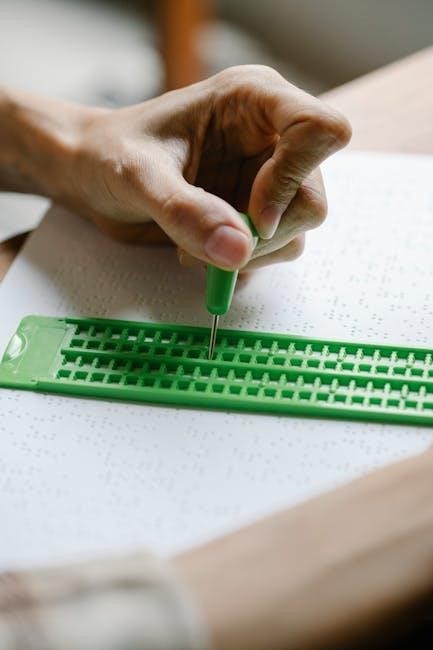The Ohio Rainwater and Land Development Manual provides guidance on stormwater management practices, defining standards for land development projects, implemented during construction, to minimize water resource impact, especially streams, with updated specifications.
Purpose of the Manual
The purpose of the Ohio Rainwater and Land Development Manual is to provide professionals with guidance on selecting, designing, and locating stormwater management practices during land development projects. The manual aims to allow development to occur while minimizing the impact on water resources, especially streams. It defines Ohio’s standards and specifications for stormwater management practices, providing updated information and research. The manual is intended for use by professionals involved in the planning, design, and implementation of land development projects. It serves as a resource for understanding Ohio’s standards for stormwater management, land development, and urban stream protection. By following the guidelines outlined in the manual, professionals can ensure that their projects meet the necessary standards and minimize environmental impact. The manual is an essential tool for anyone involved in land development in Ohio, providing valuable information and guidance on stormwater management practices. It is a key component in promoting sustainable development and protecting Ohio’s water resources.

Ohio Standards for Stormwater Management
Ohio standards for stormwater management are defined in the manual, providing guidance on practices to minimize water resource impact, with specifications for construction and development projects, and updated regulations always.
Components of the Construction General Permit
The Construction General Permit is a crucial component of the Ohio Rainwater and Land Development Manual, outlining the necessary measures to prevent stormwater pollution during construction activities. The permit requires developers to implement effective erosion and sediment control measures, as well as stormwater management practices. The components of the Construction General Permit include a stormwater pollution prevention plan, which must address all minimum components of the permit and conform to the specifications of the manual. This plan must be developed and implemented prior to the commencement of construction activities. The permit also requires regular inspections and monitoring to ensure compliance with the regulations. Furthermore, the permit outlines the requirements for sediment and erosion control, as well as the procedures for handling and disposing of waste materials. By including these components, the Construction General Permit plays a vital role in protecting Ohio’s water resources and minimizing the impact of construction activities on the environment. The manual provides guidance on how to comply with the permit requirements, ensuring that construction projects are completed in a responsible and sustainable manner.

Land Development and Urban Stream Protection
Ohio’s manual protects urban streams, guiding land development to minimize environmental impact, using best practices for sustainable development, ensuring water resource conservation and stream protection measures are implemented effectively always.
Availability of the Manual
The Ohio Rainwater and Land Development Manual is available from the Ohio Department of Natural Resources, with the second edition published in a three-ring binder format. The manual can be obtained by contacting the department directly, and it is also possible to access the information through their website. Additionally, the manual has been updated to reflect the latest research and development in the field of stormwater management, and it is considered an essential resource for professionals involved in land development projects. The manual is also available for download, making it easily accessible to a wide range of users, including engineers, architects, and developers. The Ohio Department of Natural Resources has made the manual widely available, and it can be used as a reference guide for anyone involved in land development and stormwater management in the state of Ohio, providing valuable information and guidance on best practices.

Regulatory Framework
Ohio’s regulatory framework includes laws and guidelines governing stormwater management, with specific requirements for land development projects, ensuring compliance with state and federal regulations, protecting water resources effectively always.
Best Management Practices
The Ohio Rainwater and Land Development Manual outlines best management practices for stormwater management, including design and implementation of measures to minimize stormwater runoff and protect water quality.
These practices are essential for reducing the impact of land development on water resources, and include techniques such as sedimentation control, erosion prevention, and stormwater treatment.
The manual provides guidance on the selection and design of best management practices, taking into account factors such as soil type, topography, and climate.
By implementing these practices, developers can help to protect Ohio’s water resources, including streams, lakes, and wetlands, and ensure that land development is carried out in a sustainable and environmentally responsible manner.
The manual’s best management practices are based on the latest research and technology, and are designed to be effective and efficient, while also being cost-effective and easy to implement.
Overall, the best management practices outlined in the manual are an essential tool for anyone involved in land development in Ohio, and help to ensure that the state’s water resources are protected for future generations.
The Ohio Rainwater and Land Development Manual is a comprehensive guide for managing stormwater and protecting water resources in Ohio.
The manual provides a framework for sustainable land development, balancing economic growth with environmental protection.
By following the guidelines and best management practices outlined in the manual, developers and policymakers can help to minimize the impact of land development on Ohio’s water resources.
The manual’s emphasis on stormwater management and urban stream protection is critical for maintaining healthy and sustainable water resources.
Overall, the Ohio Rainwater and Land Development Manual is an essential tool for anyone involved in land development in Ohio, providing a clear and comprehensive guide for managing stormwater and protecting the state’s water resources.

The manual’s provisions and guidelines are designed to be flexible and adaptable, allowing for innovative and effective solutions to stormwater management challenges.
The manual is a key resource for promoting sustainable land development and protecting Ohio’s water resources for future generations, and its implementation is critical for achieving these goals.